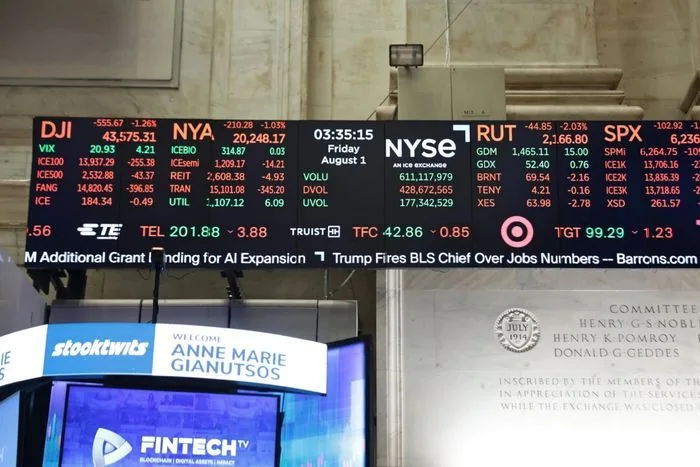By Panos Mourdoukoutas
After racing to all-time highs for a couple of weeks, U.S. equities retreated this week on profit-taking and confusion over the direction of the U.S. economy and monetary policy.
Solid earnings from technology giants such as Microsoft, Meta, and Apple failed to sustain the rally, as traders and investors chose to lock in profits rather than add to their positions. Meanwhile, mixed headlines on trade deals added to market volatility, as market sentiment switched from positive at the start of the week to negative by the end.
What seemed like another good week for the bulls turned into a celebration for the bears.
The S&P 500 Index closed at 6,238 on Aug. 1, down by 2.36 percent for the week and near the low of the day.
The Dow Jones Industrial Average lost 2.92 percent to finish at 43,588.
The technology-heavy Nasdaq Composite Index fell by 2.17 percent, to 20,650, still near the all-time high, while the Russell 2000 fared the worst, dropping by 4.17 percent.
A clear indication of the tug-of-war between bulls and bears during the week is a 36.5 percent spike in the CBOE Volatility Index (VIX), a measure of market volatility.
Wall Street opened the week higher on July 28, building on the previous week’s gains. Both the S&P 500 and the Nasdaq nudged to new highs following a trade deal between the United States and the EU over the weekend.
Adding to the positive market sentiment was an analyst upgrade of AMD, which gave another push to the semiconductor sector that has been leading the recent tech rally.
Another boost for market bulls came from higher energy prices, which helped oil stocks join the rally.
However, traders showed little conviction about the direction of the market ahead of key headlines on monetary policy due July 30, and the U.S. nonfarm payrolls report on Aug. 1.
Meanwhile, equities got little support from credit markets, as the yield on the 10-year U.S. Treasury note held steady near 4.39 percent on the day. It marked the third consecutive session of muted movement ahead of the Federal Open Market Committee’s (FOMC) interest rate decision on July 30.
Market sentiment turned negative by July 29, with stocks dropping across the board despite a decline in bond yields, as traders and investors stayed on the sidelines ahead of the Federal Reserve’s monetary policy announcement and a wave of earnings.
Big caps, including Microsoft, Meta, Apple, and Qualcomm, were set to report over the next two sessions.
Investor mood remained negative for the rest of the week amid confusion over the direction of monetary policy and the U.S. economy.
In a statement issued on the afternoon of July 30, the Federal Reserve left interest rates unchanged, citing near-full employment and persistent inflation.
“Fed chair Jerome Powell continues to see higher inflation as the greater risk to the economy, so it will take a couple of months to see how the new tariffs impact inflation and the Fed’s ability to cut rates,” Melissa Cohn, regional vice president of William Raveis Mortgage and a 43-year mortgage industry veteran, told The Epoch Times.
However, two members of the FOMC, the monetary policy arm of the Federal Reserve, dissented from the central bank’s labor market assessment, breaking a long-standing tradition of unanimity.
“The Fed is playing for time and still waiting to see how tariffs filter through into prices,” David Russell, global head of market strategy at TradeStation, told The Epoch Times.
“The two dissenting governors may be isolated wanting rate cuts because the rest of the committee seems more data-dependent. September is up in the air, likely dependent on the inflation readings for July and August. The dust hasn’t settled yet.”
Still, the lack of unanimity in the assessment of the economy left traders and investors confused. Adding to the confusion was a flurry of data that gave a conflicting picture of the U.S. economy.
A report out from the Bureau of Economic Analysis on July 30 showed that the economy grew at an annualized 3 percent in the second quarter, rebounding from a 0.5 percent contraction in the first quarter, ahead of market expectations of a 2.4 percent rise.
The rebound reflects primarily a 30.3 percent plunge in imports, following a 37.9 percent surge in the first quarter, and stronger consumer spending led by goods.
“After a bumpy first-quarter GDP reading, the U.S. saw a solid rebound in the second quarter,” Bret Kenwell, an eToro U.S. investment analyst, told The Epoch Times.
“Consumer spending remained steady, which is critical to the U.S. economy as personal consumption accounts for more than two-thirds of the GDP measure.”
Despite the strong GDP numbers, inflation, as measured by the personalconsumptionexpenditures price index in the same report, rose by 2.1 percent in the second quarter, the slowest pace since the third quarter of 2024, and very close to the Federal Reserve’s inflation target of 2 percent.
The greatest confusion came on Aug. 1, when the Bureau of Labor Statistics reported a 73,000 increase in U.S. nonfarm payrolls, well below the expected 110,000.
Meanwhile, the June numbers were revised sharply downward from an initial reading of 147,000 to just 14,000, while May’s figure was also cut by 125,000.
Overall, these numbers suggest that the U.S. economy may be cooling faster than previously thought and assessed by the Federal Reserve, meaning that the nation’s central bank may be “behind the curve” and too slow to shift from a neutral to an accommodative policy stance, such as cutting interest rates.
That sent stocks plunging and Treasury bond prices soaring, with the benchmark 10-year Treasury yield closing the week at 4.22 percent, down from the 4.4 percent at the start of the week.
“Friday’s jobs report was weaker than expected, which shows that employers still seem to be sitting on the sidelines amid elevated macro uncertainty,” Glen Smith, chief investment officer of Texas-based GDS Wealth Management, with $1.5 billion in assets, told The Epoch Times.
Smith said job growth has been slowing for several months, and the trend could prompt the Federal Reserve to cut interest rates “as soon as this fall,” noting that there is only one more jobs report before the central bank’s September meeting.
Uncertainty over the direction of the U.S. economy and monetary policy turned traders and investors decisively negative by the end of the week, despite strong earnings from tech giants, as an initial rally in the shares of these companies faded amid profit-taking.
Last, but not least, mixed headlines on trade deals added to market volatility, with the VIX spiking sharply during the day’s sell-off.
“Tariff worries are back in focus, and even though the market has remained resilient, we are still in a headline-sensitive market,” Smith said.
“Traders may be reluctant to stay in the market heading into a weekend, as weekends have typically seen significant tariff-related news and headlines. We remind investors that short-term swings can create good entry points for long-term investors. ”





